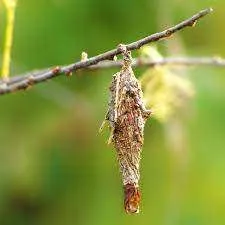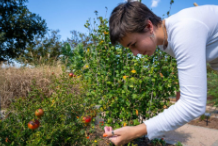Last year’s bagworm infestation was the worst I have ever seen! This year I have been getting questions earlier in the year than ever before. During the summer in Kansas, bagworms may defoliate arborvitae, junipers and other trees and shrubs. I think I saw bagworm on just about every tree and shrub that grows in Kansas last year. My dad even had a bagworm attached to his pickup truck bed! Bagworms are caterpillars that live inside spindle-shaped bags which they construct to protect themselves against birds and other enemies. These bags, composed of silken threads and bits of foliage, look so much like a part of the tree that they may go unnoticed until extensive damage has occurred. Bagworms are common throughout the state.
Early in May, the insects hatch from eggs which wintered in the old bags attached to tree branches. As soon as the young worms appear, they start to spin bags and continue to enlarge these as they feed and grow. The caterpillars crawl part way out of the bags to feed. If disturbed, they retreat safely inside, and it is almost impossible to pull them out. Each female bag can produce over 1,000 bagworms.
Often the bags are not noticed until the larvae are nearing maturation and the bags approach 1 to 2 inches in length. Mature bags hang off the tree or shrub like Christmas ornaments. Bagworms reach maturity in August. The now mature larvae attach their bags to branches or other objects and change into adults. The adult male is a small, gray, clear-winged moth that resembles a wasp. The female is wingless and legless and never leaves the bag. Males emerge in September and mate with the female through the bag entrance. The female then produces her eggs and dies. Eggs overwinter inside the bag and the cycle repeats the following year.
Small infestations can be picked off by hand once the larvae are large enough to see easily. However, any insecticide spray will be more effective if used on young larvae that are actively feeding. In Kansas, start looking for the new hatch about the middle of May. Wait several weeks after seeing the first larvae emerge to allow those still in the bag to make their appearance. This normally means spraying during the latter half of June in Kansas.
If you had a large infestation last year you might choose to spray two times this year: Spray in early to mid-June then again about 4 weeks later. Insecticides commonly used for controlling bagworms include spinosad (Conserve; Natural Guard Spinosad; Captain Jack’s Dead Bug Brew, Monterey Garden Insect Spray), acephate (Acephate, Orthene, Bonide Systemic Insect Control), cyfluthrin (Tempo, BioAdvanced Vegetable & Garden Insect Spray) and permethrin (Eight Vegetable, Fruit & Flower Concentrate; Lawn, Garden, Pet, & Livestock Insect Spray). Also, products containing Bacillus thuringiensis are effective when used against bagworm larvae while they are still small. Products containing Bacillus thuringiensis and spinosad are organic controls. THOROUGH SPRAY COVERAGE TO FOLIAGE IS ESSENTIAL FOR CONTROLLING BAGWORM! Controls applied in August are often a waste of time and expense because the larvae are large, tough and may have stopped feeding.





